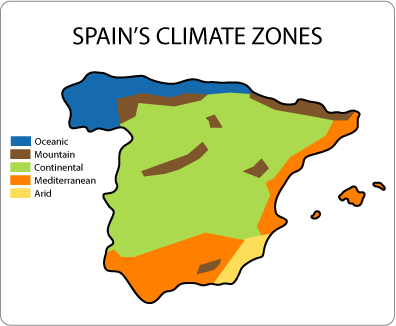Spanish Weather and Climate
The image of Spain's climate abroad has traditionally been one of blue skies and sun, while in reality it is as varied as the country's geography. At least five different climate zones characterize the Spanish climate due to the Iberian Peninsula's position between tropical (hot) and polar (cold) wind currents.

In a very general sense, the Spanish climate can be summarized as a contrast between the coast and the interior. Breezes, humidity and limited temperature ranges are characteristic of the coastal regions, while Spain's interior experiences wider temperature ranges and less humidity. Another contrast exists between the country's South (warm and dry) and North (cooler and more rainy).
| What part of Spain do you like the most? (or if you haven’t visited Spain before where do you prefer to go?) Share your opinion in our poll section and find out what other people think. CLICK HERE to participate - it only takes 30 seconds! |
Continental Climate
Spain's most predominant climate is continental, as this climate type
affects most of the country's surface area (excluding its coasts and
mountain ranges). In Spain's continental climate zone, winters are cold
enough for snows and most of the rainfall occurs in late Spring. Summers can
be hot and - in the North, which is very green - rainy.
Mediterranean Climate
Surprisingly enough, Spain's Mediterranean climate is only active throughout
one-fifth of the country, roughly speaking. Spain is traditionally
associated with a Mediterranean climate because of the popularity of its
southern and south-eastern coasts, which are located in the Mediterranean
climactic zone.
Spain's Mediterranean climate is active over nearly the entire southern
region of Andalusia as well as most of the eastern coast. Winters are
generally mild and summers vary in intensity depending on the region. For
the most part, temperatures are moderate and there is not a wide range
between the summer highs and winter lows.
Oceanic Climate
This climate zone predominates over Spain's northern coast and the
north-western region of Galicia. Unlike the Mediterranean climate in Spain –
with its hot, dry summers – this climactic zone is characterized by
extensive rainfall (thus the beautiful green landscapes of northern Spain).
Summers in Spain's oceanic climate zones tend to be warm, but not hot.
Winters are not as cold as in the continental climate zones. Precipitation
is relatively consistent throughout the year.
Mountain Climate
Spain experiences a mountain climate in areas with sizeable mountain ranges,
such as in Granada's Sierra Nevada and other mountain ranges in the
northeast, northwest (Pyrenees), midwest and southeast (Cordillera Betica).
These areas are characterized by cold winters and mild summers, with a
predominance of cold temperatures. Snow and strong winds are also common.
Arid Climate
Spain's arid climate zone takes up most of Murcia and a small corner of
Andalusia in Spain's southeast in Almeria. This area of Spain is characteristically hot
and dry, with very little rainfall. Spain's semi-deserts can be found here.